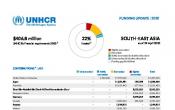Bangladesh
Operation: Bangladesh
Location
{"longitude":90,"latitude":24,"zoom_level":7,"iso_codes":"'BGD'"}
By clicking on the icons on the map, additional information is displayed.
The boundaries and names shown and the designations used on this map do not imply official endorsement or acceptance by the United Nations.
Key Figures
| 2020 planning figures | |
| 100% | of people of concern registered on an individual basis |
| 100% | of the programme priorities identified by the community are implemented |
| 42,000 | local community members benefit from projects |
| 15,000 | people of concern with specific needs receiving support |
| 2018 year-end results | |
| 40% | active female participants in leadership/management structures, 55 community groups supported and 1,563 people trained to reinforce community mobilization. |
| 200,000 | households provided for during the monsoon season by contingency stocks, and camp site development across 16 square kilometres |
| 90,000 | households provided with compressed rice-husk monthly, and 35,000 LPG stoves distributed – stemming deforestation and addressing protection needs |
| 90,000 | households received WASH and female hygiene kits regularly |
| 62,970 | emergency shelters were provided |
| 52,890 | households received core relief items |
| 143 | community-based groups working on SGBV prevention and response |
Latest Updates
People of Concern
6%
Decrease in
2019
2019
| 2019 | 854,820 |
| 2018 | 906,690 |
| 2017 | 932,334 |

[["Refugees",854782],["Asylum-seekers",38]]
Loading ...
Bangladesh
< Back
2019
{"categories":[2015,2016,2017,2018,2019,2020],"budget":[15.18430531,13.667946901,67.59621592,220.44281185,307.55339657,318.82158634],"expenditure":[7.57678278,7.28402193,49.60677532,159.89516472,175.66794425,null]}
{"categories":[2015,2016,2017,2018,2019,2020],"p1":[15.17557479,13.60402556,67.58199943,220.44281185,307.55339657,318.82158634],"p2":[0.00873052,0.063921341,0.01421649,null,null,null],"p3":[null,null,null,null,null,null],"p4":[null,null,null,null,null,null]}
{"categories":[2015,2016,2017,2018,2019,2020],"p1":[7.56913223,7.23156013,49.60571998,159.89516472,175.66794425,null],"p2":[0.00765055,0.0524618,0.00105534,null,null,null],"p3":[null,null,null,null,null,null],"p4":[null,null,null,null,null,null]}
Loading ...
CHOOSE A YEAR
- 2014
- 2015
- 2016
- 2017
- 2018
- 2019
- 2020
Year-end Overview
Working environment
Bangladesh is not a party to the 1951 Refugee Convention and it does not have domestic refugee legislation that regulates the reception and protection of refugees, however the Government and people of Bangladesh have demonstrated remarkable international solidarity by keeping their border open to those fleeing violence in the Rakhine state. Bangladesh welcomed approximately 725,000 stateless Rohingya refugees from Myanmar who fled an eruption of violence in late August 2017. UNHCR projects that there will besome 900,000 stateless Rohingya refugees in Bangladesh in 2019, including an estimated 200,000 who fled Rakhine State in previous waves of displacement.
The Ministry of Disaster Management and Relief (MDMR) and its Office of the Refugee Relief and Repatriation Commissioner (RRRC) have been assigned to oversee the refugee response. A bilateral agreement signed by the Governments of Bangladesh and Myanmar on 23 November 2017 envisages voluntary, safe and sustainable refugee returns to Myanmar. The agreement between the two States also contemplates the engagement of UNHCR to ensure that international standards are met. On 13 April 2018, the Government of Bangladesh and UNHCR signed a complementary MoU on voluntary repatriation, which reinforces this commitment to international standards and establishes a framework for enhanced operational engagement when the conditions for return are ripe.
In addition to keeping its borders open, the Government is providing land, sharing its natural resources, expending health services and investing in preparedness through a national cyclone preparedness programme. Military and civilian authorities have played a key role in organizing relief distribution, logistics and construction, closely collaborating with UNHCR and partners involved the emergency response.
UNHCR will continue to advocate for the protection of refugees regardless of their legal status and location through active participation in, and staffing support to, the existing inter-agency coordination mechanism. UNHCR will engage with different humanitarian actors focusing on local partnerships and will enhance strategic collaboration with line ministries to enhance protection space for refugees. UNHCR will continue to play a catalytic role in engaging development stakeholders, including the World Bank, UNDP, IFIs, the private sector and civil society.
Any returns of refugees should be based on a free and informed choice. Potential returns must be in line with international standards of voluntariness, safety, and dignity, and must be sustainable. The timing and pace of returns should be determined by the refugees themselves. UNHCR will provide assistance wherever refugees have voluntarily chosen to settle, in places of origin or other places, with a condition that UNHCR has full access to the areas allowing robust protection monitoring by UNHCR.
Key priorities
In 2019, UNHCR will focus on:- Securing the legal identity of Rohingya refugees which has been systematically denied in Myanmar;
- Strengthening the protective environment for refugees and ensuring their enjoyment of basic human rights;
- Improving the living conditions for refugees in settlements, while bolstering peaceful-coexistence with, and support for, host communities
- Empowering refugees and supporting the establishment of systems of governance that support resilience
- Establishing the foundation for solutions, including voluntary repatriation and alternative solutions, while establishing interim measures for refugees to live a safe and dignified existence.
























